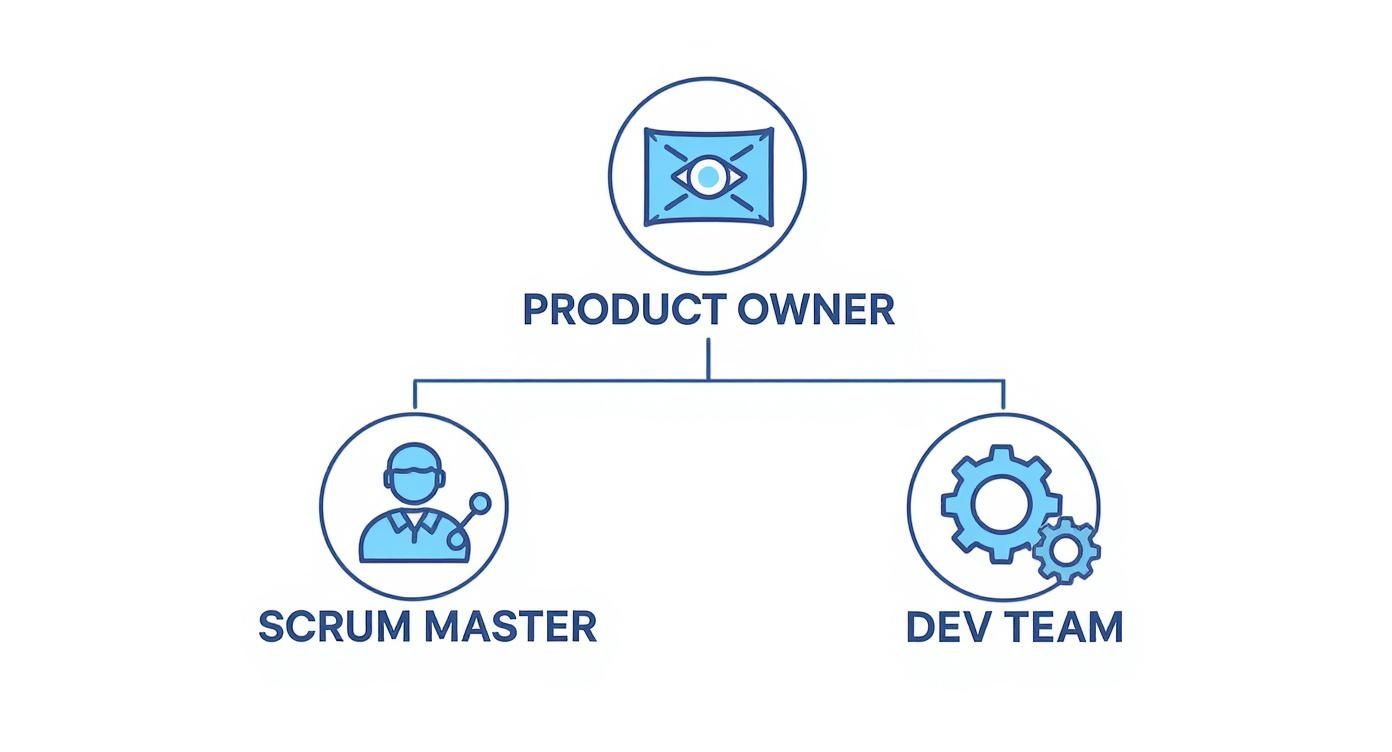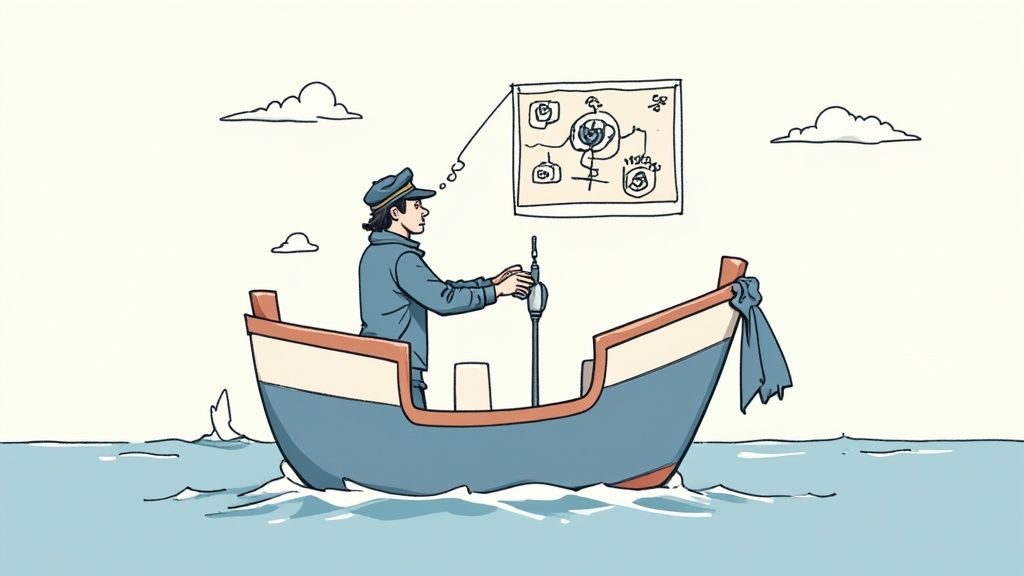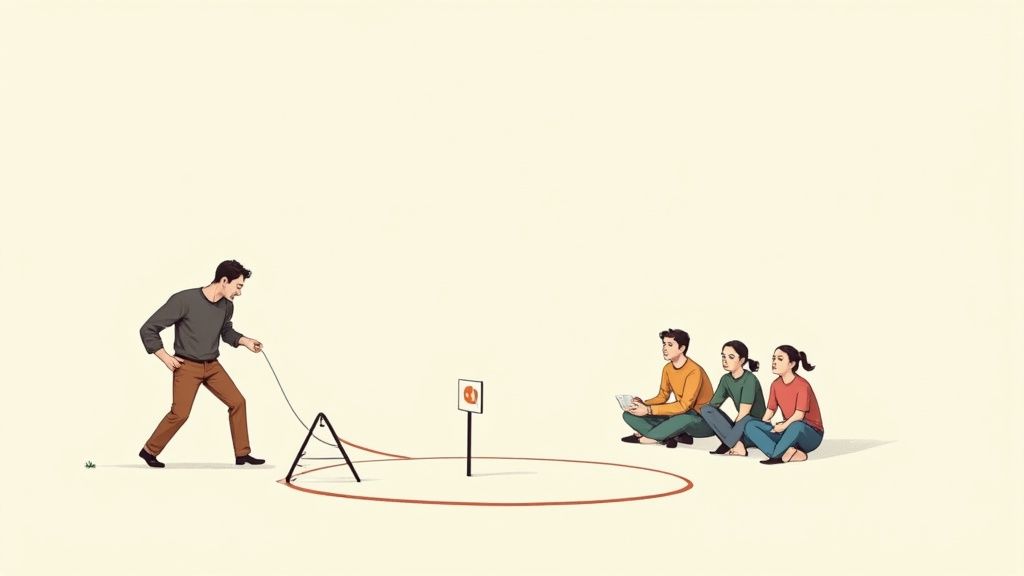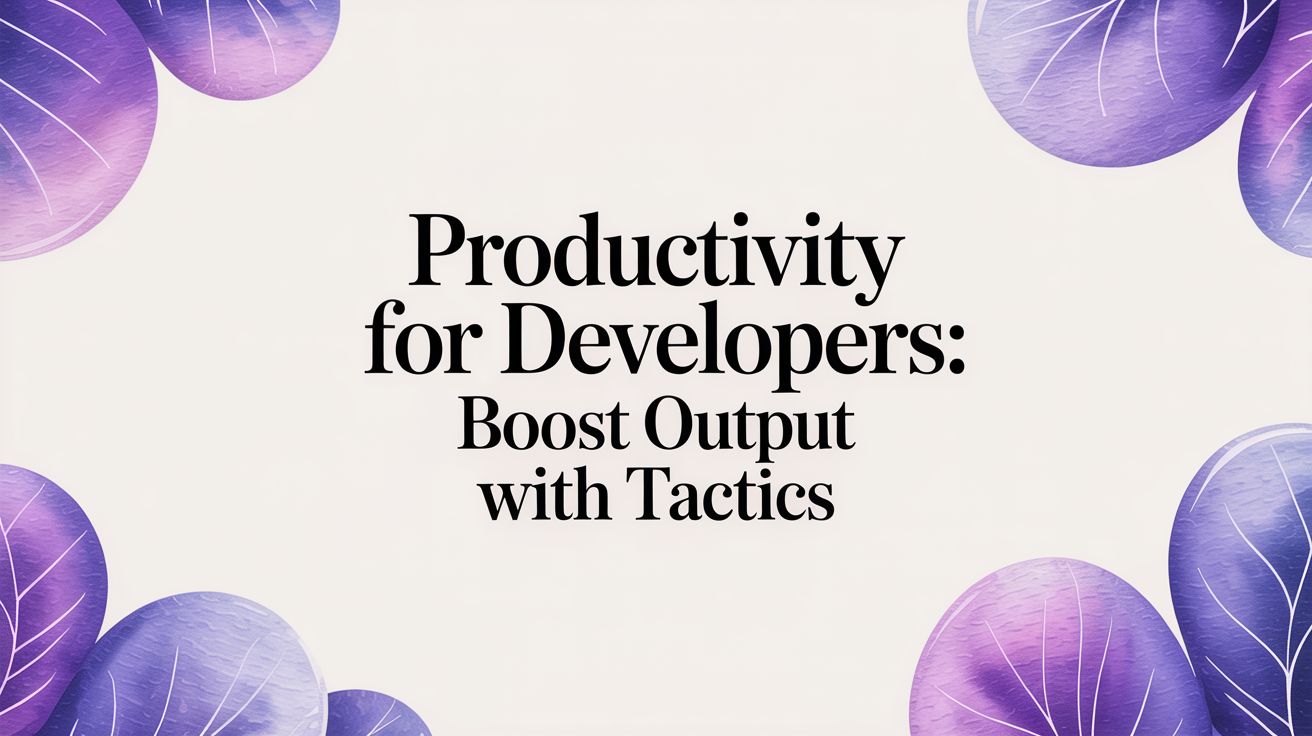In any Agile software project, success hinges on a clearly defined structure where everyone knows their part. The Product Owner maps out the vision, the Scum Master keeps the team on track and unblocked, and the Development Team brings the product to life. It’s a lot like a high-performance pit crew in a race—each person […]

In any Agile software project, success hinges on a clearly defined structure where everyone knows their part. The Product Owner maps out the vision, the Scum Master keeps the team on track and unblocked, and the Development Team brings the product to life. It’s a lot like a high-performance pit crew in a race—each person has a specific, interconnected job that's critical to winning. That synergy is what fuels a successful Agile team.
Think about a high-stakes car race. The driver’s goal is to win, but they're completely dependent on a specialized crew to get them over the finish line. The same idea holds true for the key roles in Agile software development. These aren't just rigid job titles; they're fluid sets of responsibilities designed to help the team move fast, stay efficient, and head in the right direction. It's never about one person's heroic efforts—it’s about structured, collaborative performance.
While Agile frameworks define specific team roles, it's also useful to see how they fit within the general roles and responsibilities within a business. Knowing this helps connect the dots between your Agile team's day-to-day work and the company's broader goals. The whole point is to build a self-sufficient, cross-functional team that has every skill it needs to take an idea from concept to reality.
To make this crystal clear, let's stick with our pit crew analogy to break down the primary roles:
The infographic below shows how these essential roles interact.

As you can see, the Development Team is at the heart of the action, turning the Product Owner's vision into reality with the continuous support and guidance of the Scrum Master.
To help summarize these fundamental roles, here’s a quick-reference table.
| Role | Primary Focus | Key Responsibility |
|---|---|---|
| Product Owner | Maximizing product value | Defining the product vision and managing the product backlog. |
| Scrum Master | Process optimization | Removing impediments and coaching the team on Agile principles. |
| Development Team | Delivering the product | Building a high-quality, shippable product increment each sprint. |
This simple breakdown shows how each role contributes a distinct yet essential piece to the puzzle, ensuring the team functions as a cohesive and effective unit.
Think of an Agile team as a ship on a voyage. The Product Owner is the captain at the helm, holding the map and setting the course. They decide the destination—the product vision—and chart the best route to get there. This isn't just about managing a to-do list; the Product Owner is the strategic heart of the project, responsible for making sure every bit of work the team does creates the most possible value.
Simply put, they are the final decision-maker for what gets built and the definitive voice for both the customer and the business.

A truly great Product Owner does more than just list features. They weave a compelling story about what the product can and should be. They do this by getting into the weeds—really understanding what stakeholders need, keeping an eye on market trends, and then translating all that big-picture thinking into clear, actionable user stories the development team can sink their teeth into.
The Product Owner acts as the essential link between the development team and everyone else—customers, executives, sales, you name it. By funneling all requests and feedback through one person, the team is shielded from the chaos of mixed signals and conflicting demands. It lets them focus on what they do best: building great software.
This role's importance is growing fast. As of 2025, a whopping 36% of Agile professionals hold a Product Owner title or a similar position. Even more telling, companies that give their Product Owners real authority see a 25% higher success rate in launching products that customers actually love. If you're curious about the data behind this, the latest State of Agile Report is a great place to start.
A Product Owner provides the "why" for every task. They make sure the team isn't just mindlessly coding features, but is actively solving real-world problems and creating tangible business value with every single sprint.
Their main tool is the product backlog. This is a living, breathing, prioritized list of everything needed for the product. The Product Owner owns this backlog—curating it, ordering it, and constantly refining it as new information comes to light. It’s a never-ending process of adjustment.
While the full scope of the role is deep, you can explore detailed Agile Product Owner Responsibilities to learn more. Day-to-day, their work really comes down to a few key activities:
If the Product Owner is the ship's captain, think of the Scrum Master as the expert navigator and performance coach. They're the one making sure the entire crew works together smoothly to reach the destination. This is easily one of the most misunderstood roles in Agile development, often mistaken for a traditional project manager who just assigns tasks and cracks the whip on deadlines.
Nothing could be further from the truth. A Scrum Master is a servant-leader, completely dedicated to creating an environment where the team can thrive and do its best work. They don't manage the people; they manage the process. Their entire job is to champion Scrum principles, guide the team through key events, and relentlessly hunt down and eliminate any obstacles—or impediments—slowing the team down.

This role isn't just a "nice-to-have" anymore; it's become crucial for high-performing teams. By 2025, it's projected that over 60% of Agile teams will have a dedicated Scrum Master. The investment pays off, too. Companies that bring in skilled Scrum Masters often report a 40% improvement in team productivity and a 25% reduction in project delays. You can dig into more of these numbers by checking out the latest Agile statistics.
A great Scrum Master acts like a protective shield for the development team. They run interference, deflecting external distractions and preventing scope creep so developers can stay focused on the sprint goal. When a stakeholder tries to pull a developer aside for a "quick, urgent" task, the Scrum Master steps in and politely redirects that request to the Product Owner, where it can be properly prioritized in the backlog.
They are also expert facilitators, guiding the team through the rhythm of Scrum ceremonies:
An effective Scrum Master doesn't solve the team's problems for them. Instead, they coach the team on how to solve problems themselves, fostering a culture of self-organization, ownership, and continuous improvement.
For instance, if two developers are stuck arguing over a technical approach, the Scrum Master won't just pick a side. They'll facilitate a constructive conversation, make sure both perspectives are heard, and guide the pair toward a collaborative solution that serves the project's goals. They are the guardians of the process and the champions of team empowerment, making them an absolutely indispensable part of any successful Agile setup.
If the Product Owner is the "what" and the Scrum Master is the "how," then the Development Team is the group that actually builds the thing. These are the folks in the trenches, turning ideas from a backlog into a real, working product increment at the end of each sprint.
When we say "Developer" in Agile, it's a much broader term than just "coder." It's an inclusive title for anyone hands-on in creating the product—software engineers, QA specialists, UX/UI designers, you name it. They work as a self-organizing unit, meaning they figure out the best way to get the work done without a manager dictating every move. This autonomy is what fuels the ownership and creativity that makes Agile tick.
One of the biggest misconceptions about Agile teams is seeing them as just a collection of specialists who stick to their own tasks. A truly high-performing Agile team is cross-functional. This means the team has all the skills it needs—design, coding, testing, etc.—to take a feature from an idea to a finished, shippable state. There are no hand-offs to other departments.
This is where the magic really happens. Instead of a designer creating mockups and tossing them "over the wall" to an engineer, they work together from day one. This constant collaboration ensures the design is actually buildable and that a great user experience is baked in, not just bolted on at the end. It's a simple-sounding shift that dramatically cuts down on wasted time and rework.
The power of a cross-functional team comes from shared ownership. Quality isn't just the QA person's problem, and a clunky interface isn't just the designer's fault. Everyone on the team owns the success of the entire product increment.
Now, "cross-functional" doesn't mean every person is an expert in everything. Deep specialization is not only welcome but absolutely necessary for building a great product. The goal is to create a team with a healthy mix of "I-shaped" people (deep experts in one area) and "T-shaped" people (deep experts who also have a broad understanding of other areas). This T-shaped skill set prevents bottlenecks when a sprint is heavy on, say, design work or testing.
Let's look at how these specialists contribute while working in tight, collaborative loops.
A look at the unique responsibilities and collaborative activities of key specialists within a cross-functional Agile team.
| Specialist Role | Primary Contribution | Key Activities |
|---|---|---|
| Software Engineer | Writes clean, maintainable, and functional code to build product features. | Pairs with designers on UI implementation, works with QA to understand test cases, and participates in code reviews. |
| QA Specialist | Champions a quality-first mindset and builds frameworks for testing and validation. | Works with the PO to define acceptance criteria, creates automated test scripts, and collaborates on bug prevention strategies. |
| UX/UI Designer | Ensures the product is intuitive, solves real user problems, and is visually appealing. | Conducts user research, creates prototypes for feedback, and works side-by-side with engineers to ensure pixel-perfect execution. |
These specialists don't work in isolation. A designer might sit with an engineer to get a new UI component just right, while a QA specialist provides input to both before any code is even written. This continuous feedback loop is what transforms a group of individuals into a cohesive, high-velocity team.
If you're looking to assemble a team with this level of integrated expertise, you can find the right specialists by exploring a wide range of vetted agile software development skills.
When you’ve got a single Agile team knocking it out of the park, the temptation is to just clone them. But scaling Agile isn’t about copy-pasting teams; it's about evolving your entire system. As you grow, you'll hit new roadblocks around coordination, keeping everyone aligned, and maintaining that Agile spark that made you successful in the first place.
This is where you need to think bigger. Imagine a fantastic local sports team. Now, picture running a whole professional league. You wouldn't expect one coach to manage every team, right? You'd bring in a league commissioner or a director to orchestrate everything. In the world of Agile, that's your Agile Coach.
A Scrum Master is in the trenches with a single team, clearing their path day to day. The Agile Coach, on the other hand, operates from a 30,000-foot view. They mentor the Scrum Masters, act as a strategic guide for leadership, and serve as the guardian of Agile principles across the entire company.
Their job isn't just to fix one team's problems; it's to spot and resolve the systemic issues holding everyone back. This role is proving its worth—companies with skilled Agile coaches consistently report happier teams and quicker delivery times. The demand is real, too: projections show that by 2025, around 50% of Agile coaches will earn between $120,000 and $300,000 annually. You can find more data on the impact of Agile coaching on project outcomes.
An Agile Coach helps an organization not just do Agile, but be Agile. They foster a mindset of continuous improvement that scales from the team room to the boardroom, ensuring growth doesn’t compromise agility.
As more teams come online, informal coordination breaks down. This is when companies often turn to established scaling frameworks like the Scaled Agile Framework (SAFe) or Large-Scale Scrum (LeSS). These aren't just rulebooks; they introduce specific roles designed to manage complexity at scale.
Release Train Engineer (in SAFe): Think of this person as the head Scrum Master for an "Agile Release Train"—a collection of teams all working together on a major solution. They keep the whole train on the tracks.
Area Product Owner (in LeSS): When multiple teams are building a single massive product, this role takes ownership of a large chunk of the product backlog, making sure all the pieces fit together seamlessly.
These roles are the glue that holds everything together, keeping dozens of developers aligned on a single, shared vision. For companies looking to expand, exploring the benefits of outsourcing custom software development can be a smart move, giving you instant access to talent already fluent in these scaled environments.
Knowing the Agile roles is one thing; building a team that actually clicks is another beast entirely. The magic of a high-performing Agile team isn't just about hiring a bunch of technical geniuses. It's about finding people who have the right mix of hard skills and the often-overlooked soft skills—communication, collaboration, and a real hunger for solving problems.
Time and time again, I've seen a team of brilliant but siloed specialists get completely outpaced by a cohesive group that truly owns the work together.
When you're hiring, you have to look past the resume and find the right mindset. A great Product Owner isn't just a backlog manager; they need sharp business sense. An effective Scrum Master is more of a coach and facilitator than a taskmaster. These aren't just job titles; they’re a reflection of someone's core strengths.
Vague job descriptions attract vague, uninspired candidates. If you want to find the right people for your Agile team, you have to get specific about what you're really looking for. Don't just list a bunch of generic duties—describe the impact you expect them to have.
This approach filters for candidates who are genuinely bought into Agile principles, not just people hunting for a paycheck.
The best Agile teams are built on a foundation of trust and shared purpose. Technical skills can be taught, but a collaborative spirit and a commitment to continuous improvement are what truly drive success.
How you structure the team is just as important as who's on it. A tiny startup can get by with a scrappy team where everyone wears multiple hats. But a large enterprise needs more specialized roles to navigate complexity.
A good guideline is the "two-pizza rule"—if you can't feed your team with two large pizzas, it’s probably too big. Keeping teams small (typically 5 to 9 members) keeps communication tight and decision-making quick.
Of course, the biggest hurdle is finding the right talent in the first place. A tough, thorough screening process is non-negotiable. To see what a top-tier process looks like, learn more about HireDeveloper's comprehensive vetting process for developers, which is designed to identify the top 1% of candidates. Building the right team is an investment that pays for itself in every single sprint.
Getting Agile roles right can feel like a puzzle, especially when you're just starting out. It's totally normal for questions and a bit of confusion to pop up as your team gets into the rhythm of daily work. Let's clear the air on some of the most common questions we hear.
Getting these answers straight helps everyone pull in the same direction.
This is a classic question, and while it might look like a smart way to streamline costs, it's a move that's strongly discouraged. Think of it this way: the roles are designed to have a healthy tension. The Product Owner is laser-focused on delivering maximum value, which often means pushing for more features and a bigger scope. The Scrum Master, on the other hand, is the team's guardian, protecting their ability to work at a sustainable pace.
When you merge these roles, you create an instant conflict of interest. It's like asking someone to be both the team's coach and the game's referee. You simply can't do both jobs well without one seriously compromising the other.
The sweet spot, according to the Scrum framework, is a core Development Team of three to nine members. This isn't just an arbitrary number; it hits a crucial balance. It's small enough to stay quick on its feet and keep communication simple, but big enough to have all the skills needed to get a real chunk of work done in a sprint.
Teams that are too small often have skill gaps that create bottlenecks. Teams that are too large get weighed down by communication overhead—too many meetings, too much coordination—and everything just slows to a crawl.
Stakeholders are absolutely essential for success, whether they're customers, executives, or people from other departments. But, and this is a big but, they aren't part of the day-to-day Scrum team. Their main line of communication should always, always be the Product Owner. The PO is the one who masterfully translates all that feedback and those big ideas into a prioritized product backlog.
The most important time for stakeholders to get involved is during the Sprint Review. This is their chance to see the latest working software with their own eyes and give direct feedback. That input is gold, helping the team and the Product Owner figure out what to tackle next.
While it’s true that quality is everyone's job in an Agile team, having a dedicated QA specialist is incredibly valuable. Their role is so much more than just catching bugs before a release. A great QA specialist instills a quality-first mindset right from the start.
They help write solid acceptance criteria, push for better test automation, and hold the team accountable to its "Definition of Done." This proactive focus on quality doesn't just prevent bugs; it builds a more stable, reliable product with every single sprint.
TypeScript has become a core competency for modern software development. As its adoption skyrockets, so does the demand for engineers who can wield its type system with precision and strategic foresight. Demonstrating this expertise under interview pressure, however, presents a unique challenge that goes beyond recalling basic syntax. This guide moves past simple Q&A lists […]

For a long time, the software world got developer productivity all wrong. We measured what was easy to see, not what actually mattered. Redefining Developer Productivity Beyond Code Ask any old-school manager how they measured a developer's output, and you'd likely hear about lines of code, the number of commits, or how many tickets they […]

In a world saturated with data, the ability to transform raw numbers into clear, actionable insights is a critical competitive advantage. For CTOs, product leaders, and engineering managers, effective data visualization serves as the essential bridge between complex datasets and strategic decision-making. A well-designed chart can reveal hidden trends and empower teams to act decisively, […]
